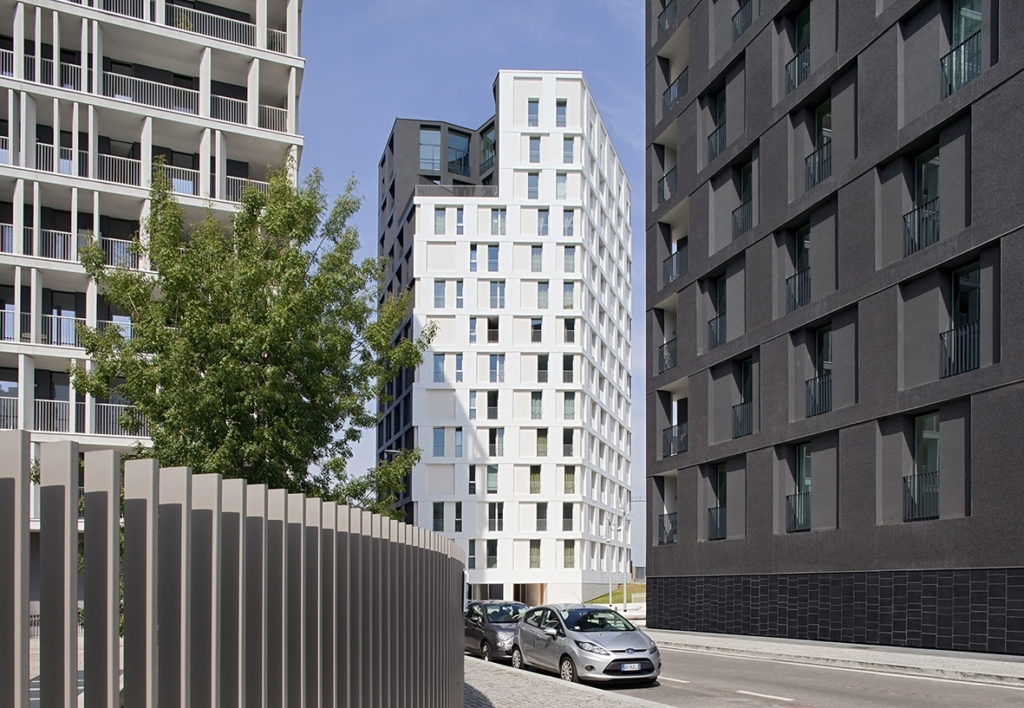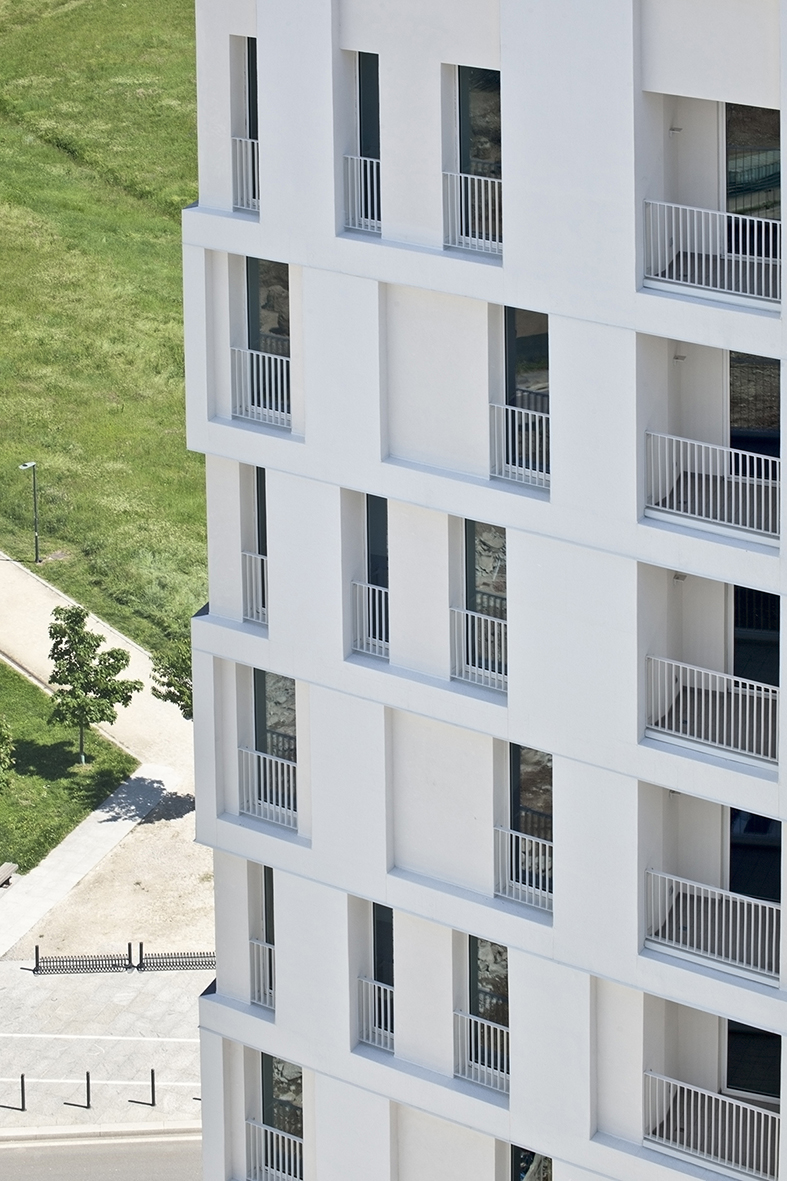NAME
Project title: Social Housing Towers in Cascina Merlata
Recommending party
The project has been submitted by:
Maria Alessandra Segantini

URBAN CONTEXT
COMMUNAL / TYPOLOGICAL APPROACH

D – DETAILS – DATI
Plot area – Superficie lotto: mq 22.500
Gross Area – Superficie lorda totale: mq 10850
Of which
residential – Di cui Residenziale: 9850 mq
Public/communal areas – Spazi collettivi/comuni: 5000 mq
Facilities for the public – Attrezzature pubbliche: 1000 mq
Business/trade – Commerciale: % 0
Offices – Uffici: % 0
Number of residential units – Numero di alloggi: 104
Typology of users – Tipologia di utenti:
Total building costs Euros – Costo di costruzione totale in Euro: € 18.000.000 Mio
Building Cost = Total Bulding Cost / Gross Area – Costo di costruzione = Costo di costruzione totale /Superficie lorda totale: 1.658 €/mq
Floor area ratio = Gross Area / Plot Area – Densità = Superficie lorda totale /Superficie lotto: 0,48
Work started on date – Data inizio lavori: giugno 2019
Work completion date – Data ultimazione lavori: gennaio 2022
E – OWNERSHIP – PROPRIETA’
Promoter – Promotore
Institut Balear de l’Habitatge (IBAVI)
Allotment rule – Regola di assegnazione: Investire sgr
Reduction cost percentege compared to the market value – Percentuale di riduzione di costo rispetto al valore di mercato:
assignement %: 100
rent %: –
GENERAL PLANS – PLANS
G – CANDIDATURE REPORT – RELAZIONE DI CANDIDATURA
ECONOMIC SUSTAINABILITY | SOSTENIBILITÀ ECONOMICA
Il progetto è stato appaltato prima del Covid con costi di mercato più bassi che sono stati mantenuti tali, ben sotto la media di mercato. Infatti il costo di costruzione è 1.658 euro al mq.
Rental/sale cost compared to market price
Costo di affitto/ vendita rispetto al mercato
Il costo di vendita al mq è circa 2/3 del costo al mq nella stessa area per il mercato libero.
TYPOLOGIES
SOCIAL SUSTAINABILITY – SOSTENIBILITÀ SOCIALE
Rules of allocation – Regole di assegnazione
Gli appartamenti sono stati tutti venduti a canone calmierato secondo le graduatorie di Regione Lombardia.
Protection of fragile categories
Tutela categorie fragili
No.
Involvement of inhabitants in the building process – Coinvolgimento degli abitanti nel processo
Un progetto di partecipazione in collaborazione con la Fondazioni Housing Sociale è stato operato per progettare il playground colorato.
Community accompaniment in the life of the building – Accompagnamento della comunità nella vita dell’edificio
E’ stato realizzato un manuale e incontri speciali per spiegare il funzionamento e le poptenzialità dell’edificio.
SIGNIFICANT SECTIONS
ENVIRONMENTAL SUSTAINABILITY
SOSTENIBILITÀ AMBIENTALE:
Functional mixitè – Mix funzionale
I piani terra delle due Torri ospitano spazi collettivi multifunzionali, una palestra, una sala giochi per i bambini e un playground, uno spazio per il waste management e le riparazioni delle biciclette, una lavanderia.
Common spaces and shared living – Spazi comuni e abitare condiviso
Tutti gli spazi sopra descritti sono ad uso degli abitanti. Il progetto ha tuttavia deciso di demolire le recinzioni per un terzo del lotto trasformando la gated community in una piazza aperta, accessibile a tutti e costruita in materiali durevoli.
Techniques and strategies for environmental saving:
Utilizzo di sonde geotermiche, pompe di calore, fotovoltaico, recupero dell’acqua piovana per l’irrigazione.
BRIEF DESCRIPTION OF THE PROJECT
Design is our tool to fight for the public good.
In Cascina Merlata, in Milan, we feel we have turned an affordable housing project into an action to defend public space and give it back to the community. The plot R11 is located at the Northern end of the Highrise Village, bordering the park of Cascina Merlata, the largest housing development in Europe. Initially planned as a volume surrounded by a fence and meant to be a ‘gated community’, we have proposed to break the plot into two parts to give back the community a public space and create an ‘urban door’ between the Village and the Park.
The new Piazza is an open and accessible space for all people relating the different heights of the street and the park and creating a threshold between the built and nature.
The project is critical of the concept of the ‘gated community’. By giving back public space to the surrounding community, we physically design a square in material and chromatic continuity with two towers of affordable housing, which underlines the importance of sharing the collective space as a key point to strengthen the identity of the community. The square is a fun public space capable of turning into into a playground for children or skaters, for rest and play.
Made of white Prun stone, the square is dotted with a series of circular benches, which have been positioned to prevent the intrusion of cars. The mono-material and monochromatic space underlines the urban role of the complex as a threshold space between the park and the city. A difference in height of about two meters between the road and the park is overcome with the design of 5% sloped planes.
On the sides of the square two towers (fourteen and twelve meter high) define the space and seem to have been generated from the same volume, split in two by the public space. The two towers develop 10,830 square meters, distributed in 103 flats, all sold as affordable housing according to the Regional regulations. The ground floor of both towers houses the entrance hall and service spaces, such as bicycle storage, common room, gym, laundry and storage room for separate waste collection. C+S project was a pioneer, in 2011, in introducing ESG drivers when inserting hybrid and common spaces within the residential complex.
The towers are arranged on two underground levels of parking for 104 cars, technical spaces and cellars as well as a colorful outdoor playground for children that was designed with a participatory project in collaboration with the Social Housing Foundation.
The total one hundred and three apartments, all sold in record time immediately after the construction site started, are built in energy class A and provide, according to the well-established sustainability strategies, a geothermal district heating and cooling system on the floor, one for controlled mechanical ventilation and photovoltaic systems, in order to reduce emissions and consumption.
The towers, bent, modeled and oriented to ensure that all the apartments could enjoy the view of the surrounding green, have a different material treatment on the fronts: the elevations, strongly rhythmic, are designed by full-height windows, which are cladded with the same white stone of the square up to the first level, creating a continuity between the horizontal and vertical planes, while on the outside, towards the village, they are finished with a darker coating, chromatically matching the adjacent towers. The darker color of the side fronts helps to underline the strength of the incision of the collective space of the square, which is transformed into the ‘door to the park’.
From the second floor the cladding of the towers becomes a glass mosaic, recalling some finishing of the masters of Italian Architecture (Gio Ponti’s precious interiors or Moretti’s light textures), and to mean that the city is defined by precious urban interiors to inhabit.
The finish of the facades (beyond the ground floor) consists of a coating insulation, on which the
Sicis-type glass mosaic is not a flat coating. Each tile is variable in section. This choice allows the façade to transform itself by reflecting the light in a different way every minute of the day. The façade seems to light up and change: it is activated by the variation of daylight and climatic changes.
The composition of the façade is simple and has a regular mesh on which a series of differentiated stratifications are drawn in depth. The main pattern is determined by the regular design of a grid of large square openings that defines the size of the loggias. The texture is thus characterized by the irregular alternation of loggias, windows and blind parts covered with colors in accordance with the mosaic.
Each material was also chosen for its durability and recyclability over time.
With the completion of the two R11 towers and the square, we are honored to have entered that contemporary laboratory, that has become the city of Milan in the last decade, while remaining consistent with our own research. We firmly believe in the potential of a free, well-designed public space capable of being activated by people, their memories, their dreams and their experiences to create future memories and shape their identity.
We believe that design is our day-by-day attitude to enhance the democratic values of our time designing for the public good.
GALLERY